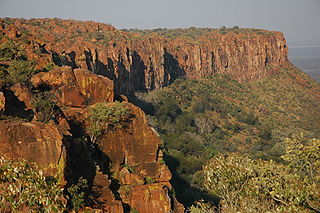 W
WFossiliferous stratigraphic units in Namibia are not as numerous as in neighboring South Africa, but several formations have provided unique fossil assemblages, particularly the Ediacaran fauna of the Vendian to Cambrian Nama Group, fossil fish in the Carboniferous to Permian Ganigobis Formation and Eocene Langental Formation, typical Permian Gondwanan biota in the Huab, Gai-As and Whitehill Formations, Early Triassic therapsids in the Omingonde Formation, Early Jurassic dinosaur trackways in the Etjo Sandstone and Early Miocene mammals and reptiles in the Elisabeth Bay Formation.
 W
WThe Black Crow Limestone is an Early Eocene geologic formation in the Sperrgebiet, ǁKaras Region of southwestern Namibia. The limestones of the approximately 10 metres (33 ft) thin formation were deposited in a lacustrine to paludal environment. The formation provides many fossil mammals and amphibians, reptiles, fresh water snails and fish.
 W
WThe Dwyka Group is one of four geological groups that compose the Karoo Supergroup. It is the lowermost geological group and heralds the commencement of sedimentation of the Karoo Supergroup. Based on stratigraphic position, lithostratigraphic correlation and palynological analyses, these lowermost Karoo strata range between the Late Carboniferous (Pennsylvanian) to Early Permian in age.
 W
WThe Elisabeth Bay Formation, alternatively spelled as Elizabeth Bay Formation, is an Early Miocene geologic formation in the Sperrgebiet, ǁKaras Region of southwestern Namibia, overlying the Blaubok Conglomerate. The freshwater green and red siltstones, sandstones, intercalations of conglomerates and claystones of the formation were deposited in a fluvial environment, infilling a paleovalley incised during the Oligocene low sea stand, which backfilled during the Burdigalian marine transgression. The Elisabeth Bay Formation provides many fossil mammals, snakes and other reptiles.
 W
WThe Etjo Sandstone is an Early Jurassic geologic formation in northern Namibia. The formation overlies the Omingonde Formation in the Waterberg Basin and the Doros and Gai-As Formations in the Huab Basin and has a total thickness of 140 metres (460 ft). Fossil theropod tracks of Prosauropoda indet., Theropoda indet., Tetrapodium elmenhorsti, Saurichnium anserinum, S. damarense, S. parallelum and S. tetractis have been reported from the formation, deposited in an aeolian environment.
 W
WThe Gai-As Formation is an Early to Middle Permian geologic formation correlated with the Ecca Group and designated "Ecca" Group, because it does not belong to the Karoo, in the southwestern Kunene Region and northern Erongo Region of northwestern Namibia. The Gai-As Formation represents the second-oldest sedimentary unit of the Huab Basin, overlying the Huab Formation. The formation was deposited in a fluvial to lacustrine setting.
 W
WThe Ganigobis Formation is a Late Carboniferous (Gzhelian) to Early Permian (Artinskian) geologic formation of the Dwyka Group in the ǁKaras Region of southeastern Namibia and the Northern Cape of South Africa. The widespread formation was deposited in the Aranos and Karoo Basins of southern Africa.
 W
WThe Huab Formation is an Early Permian geologic formation correlated with the Ecca Group and designated "Ecca" Group, because it does not belong to the Karoo, in the southwestern Kunene Region and northern Erongo Region of northwestern Namibia. The Huab Formation represents the oldest sedimentary unit of the Huab Basin, overlying the basement. The oil shales within the formation were deposited in a shallow lacustrine environment, and the formation marks the transition from terrestrial deposits under glacial climatic circumstances towards a warmer fluvial and marine deltaic environment.
 W
WThe Karoo Supergroup is the most widespread stratigraphic unit in Africa south of the Kalahari Desert. The supergroup consists of a sequence of units, mostly of nonmarine origin, deposited between the Late Carboniferous and Early Jurassic, a period of about 120 million years.
 W
WThe Langental Formation, also spelled as Langetal Formation, is a Late Eocene geologic formation cropping out in the Sperrgebiet, ǁKaras Region of southwestern Namibia. The siltstones and sandstones of the formation were deposited in a shallow marine environment. The Langental Formation was deposited under hot and humid conditions. The formation overlies the Silica Beds unit and is overlain by the Blaubok Conglomerate. The Langental Formation provides many fossil invertebrates and fish.
 W
WThe Nama Group is a 125,000 square kilometres (48,000 sq mi) megaregional Vendian to Cambrian group of stratigraphic sequences deposited in the Nama foreland basin in central and southern Namibia. The Nama Basin is a peripheral foreland basin, and the Nama Group was deposited in two early basins, the Zaris and Witputs, to the north, while the South African Vanrhynsdorp Group was deposited in the southern third. The Nama Group is made of fluvial and shallow-water marine sediments, both siliciclastic and carbonate. La Tinta Group in Argentina is considered equivalent to Nama Group.
 W
WThe Omingonde Formation is an Early to Middle Triassic geologic formation, part of the Karoo Supergroup, in the western Otjozondjupa Region and northeastern Erongo Region of north-central Namibia. The formation has a maximum thickness of about 600 metres (2,000 ft) and comprises sandstones, shales, siltstones and conglomerates, was deposited in a fluvial environment, alternating between a meandering and braided river setting.
 W
WThe Whitehill Formation, alternatively written as White Hill Formation and formerly known as White Band or Whitehill or White Hill Member, is a regional Early Permian geologic formation belonging to the Ecca Group in the southeastern ǁKaras Region of southeastern Namibia and Eastern, Northern and Western Cape provinces of South Africa.